
- •Foreword
- •Preface
- •Key to Diagrams
- •Reading Pressure and Options
- •Reacting to Support the Breakout
- •Breakout Plays
- •Control Breakouts
- •Counters
- •Regroups
- •Dump-In Entries
- •Mid-Ice Entries
- •Wide-Lane Drives
- •The Funnel
- •Two-on-One Attacks
- •Two-on-Two Attacks
- •Three-on-Two Attacks
- •Offsides
- •Activating Defense Into Offensive Zone Entries
- •Cycling
- •Playing Behind the Net
- •Stretching the Zone: Low-High Plays
- •Activating Defense in the Offensive Zone
- •Attack Zone Plays
- •Power-Play Breakouts
- •Gaining and Maintaining Possession off the Entry
- •Zone Setup
- •Five-on-Three Power Play
- •Four-on-Three Power Play
- •Forechecking Systems
- •Neutral Zone Forechecking
- •Neutral Zone Forechecking Systems
- •Neutral Zone Backchecking
- •Neutral Zone Backchecking Systems
- •Handling Defensive Zone Entries
- •Defensive Zone Systems
- •Situational Guidelines for Defensive Zone Coverag
- •Face-Offs and Penalty Kills
- •Forechecking and Penalty Kills
- •Pressuring the Entry
- •Defensive Zone Play
- •Three-on-Five Penalty Kill
- •Three-on-Four Penalty Kill
- •Offensive Zone Face-Offs
- •Neutral Zone Face-Offs
- •Defensive Zone Face-Offs
- •Power-Play Face-Offs
- •Penalty-Kill Face-Offs
- •Special Face-Off Situations
- •Managing Staff
- •Dealing With Officials
- •Adjusting Your Playing Strategy
- •Managing Lines
- •Line Changes
- •Handling the Moment
- •Index
- •About the Authors
Handling Defensive Zone Entries
Once the puck carrier crosses the line there are a number of options available to the offensive team as outlined in Chapter 3. To develop your team in the area of handling defensive zone entries you need to review each of these with them and how they are to execute, if facing that situation. Whether your team is faced with an attacker who delays, a two on one, two on two, or any variation of a three on two, three on three . . . they will know how to play it.
It is important to note here that for all entries described we focus primarily on the two defense and the first backchecking forward (figure 8.1). As mentioned in the backchecking chapter, the last two forwards coming back in the zone come back hard through mid-ice (inside the dots) and stop at the top of the circles in the defensive zone. Keep sticks on the ice to discourage passing options.
Figure 8.1 Handling the rush with two defense and a backchecking forward.
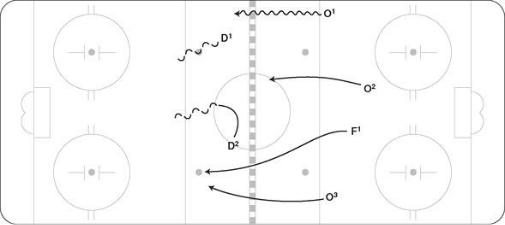
Delays
If the opposing forward delays when entering the offensive zone, first read whether the rush is even. If the offensive team outnumbers the defensive team, then the defense should hold inside position and wait for help. There are two ways to play an even rush where the puck carrier delays. D1 steps up and plays the puck carrier while F1 locks mid-ice and protects the space behind D1 (figure 8.2a). F1 looks for late players coming into the zone and D2 plays the middle to wide side area. D2 will automatically take any mid lane net drives. The second way to play an even-rush delay is to have the backchecking forward go after the puck carrier while both defenseman drop back inside with their sticks on the ice, ready to take away any plays inside and cover players going to the net (figure 8.2b). Either way is effective, but teams should pick one of these strategies and stick to it so that both the defense and forwards always know who is going to take the delay player and who is going to stay inside.
Figure 8.2 (a) D1 playing the delay. (b) F1 playing the delay.
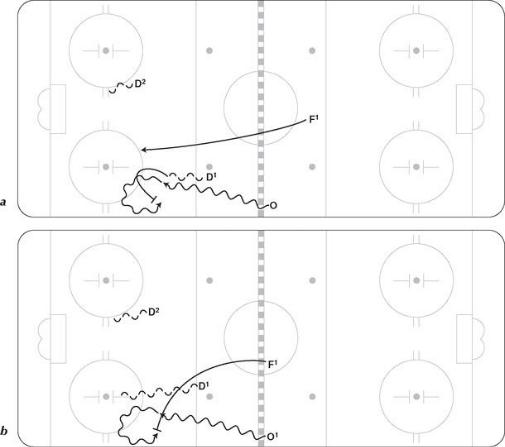
Two on One
Coaches have several different theories about how to play a two on one, but there is no factual evidence to say which is better. First, the defenseman should stay in mid-ice regardless of whether the two on one is down the middle or wide. Early, try to push the puck carrier wide. Once the attack moves into the circles, the defenseman has two options:
1. Be responsible for the player without the puck, and leave the player with the puck to the goaltender. To execute this tactic the defense must turn to take the wide player at the last moment in order to minimize the risk of the opposition puck carrier cutting to a better shooting position. When the defense turns to take his check, he should still keep an eye on the puck carrier so he knows what is happening. The primary responsibility of the defenseman in this tactic is to make sure no pass can be made to the back door for an empty-net tap-in (figure 8.3a).
Figure 8.3 During the two on one the defenseman either (a) makes sure no pass can be made back door or (b) slides flat on the ice with feet facing the net to take away the passing option.
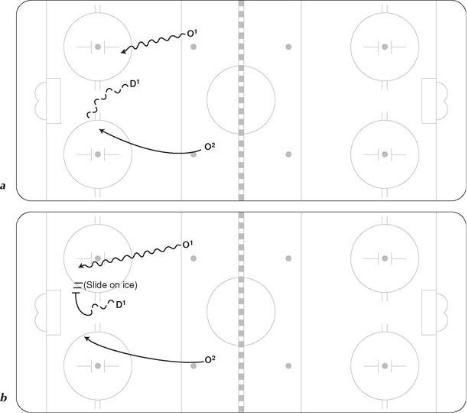
2.The second way to play a two on one is for the defense, to slide flat on the ice with feet facing the net to take away the passing option and force the puck carrier to shoot (figure 8.3b). This slide must be executed with proper timing. The problem with the slide is that until they perfect it many defensemen slide too far or leave their feet to early— allowing the puck carrier to cut in. Also once the defenseman sides he is in no position to defend a rebound.
Two on Two
In all two-on-two situations, the defensemen should make sure they have a tight gap. Without a tight gap, it is difficult to play the two on two properly. In order to maintain a tight gap defense should be constantly be reminded to “gap up” which means to move up with the play and tighten up on the rush. Keep two stick lengths as a reference point - any further back and the defense will lose the ability to move back at the same speed as the rush. There are two ways to play a two on two, and both have their strengths and weaknesses.
The first is for D1 to stay with the puck carrier regardless of what he does. If the puck carrier drives, delays, or cuts to the middle, then D1 stays with him and D2 keeps position on the other player. The strength in playing it this way is that there is no confusion as to who has whom, while the weakness is that sometimes the offensive team can lose coverage, especially when the puck carrier crosses with the second offensive player (figure 8.4a).
The other way to play a two on two is for D1 to take the puck carrier on the drive or delay but when the puck carrier crosses the ice, D1 leaves him for D2 to play. Now D1 picks up the other player (figure 8.4b). The disadvantage here is that D2 might not be in a strong position to pick up F1, and D2 might miss coverage on F2 in the exchange. The advantage is that both Ds always stay in good mid-ice position and know that they have their own side of the ice to cover.
Figure 8.4 (a) In a two on two, one option is for D1 to stay with the puck carrier no matter what (continued on next page).
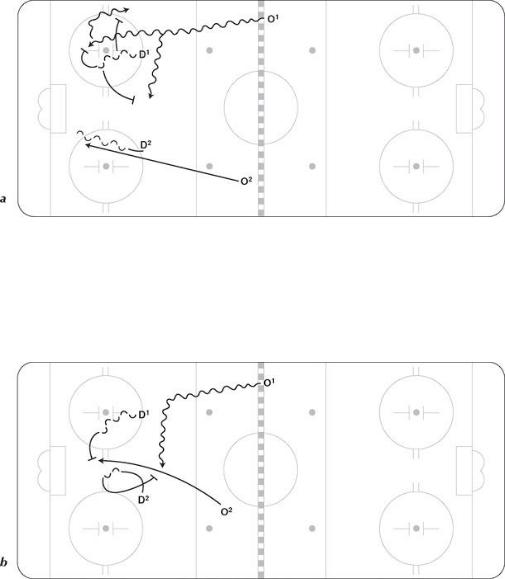
Figure 8.4 (continued) In a two on two, a second option is for D1 to leave the puck carrier for O2.
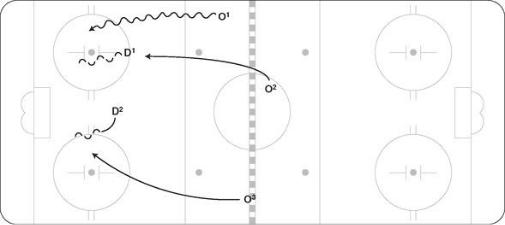
Three on Two
When reading a three on two, both defensemen stay in mid-ice and try to delay the attack. Don’t confuse what looks like a three on three for what really is a three on two. What I mean here is that at times the defense will say that “I thought the backchecker had the third player” but in reality the backchecker is a step away and couldn’t catch the player. If the offensive team sends a back-side drive, the strong-side D1 now plays the two on one, and the backside D2 goes with the drive (figure 8.5). If it is a midlane drive, the back-side D2 plays the two on one, trying to shade (commit to one player while ready to take the other player) the drive player but ready to come out on the wide pass. D1 plays the puck carrier.
Figure 8.5 Defending a three on two back-side drive.
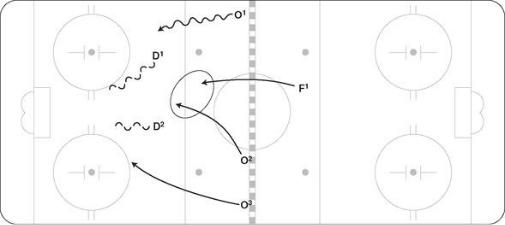
Three on Two With a Close Backchecker
In this situation the backchecker is close to catching the rush but doesn’t have position on any of the offensive players (figure 8.6). D1 and D2 should play it as a three on two until the backchecker has caught the opposition’s highest player. With the new obstruction rules not allowing the backchecker to hook the offensive player, do not play it like a three on three until the offensive player is clearly caught by the backchecker. Make sure the backchecker has body position on his player before the Ds adjust and play it as a three on three. It is better to play it safe until you are sure because as soon as one of the defense overplay the outside it could open up a two on one inside if the backchecker is not in position.
Figure 8.6 A three on two with a close backchecker.
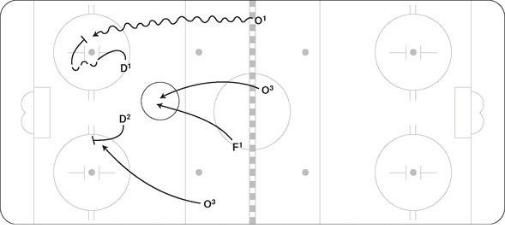
Three on Three
The backchecker must identify the player he is covering. As outlined in the backchecking chapter (pages 118-120), some teams like their backchecker in the wide lane and some like him in the mid-ice lane, so the defensemen adjust according to the team’s system. Usually the backchecker will take the highest player unless he is already in position to take the wide player. Keep your stick off the body of the free player so you don’t take a penalty and get good body position. Good body position is where you are close enough to the player to take his stick and at the same time keep an eye on where the puck is (figure 8.7).
Figure 8.7 The backchecker taking the highest player.
If the backchecker is coming back through mid-ice, he should leave any drive players to the defense and pick up the higher areas. Therefore if the middle offensive player drives the net looking for a pass or deflection then this player would be covered

by D2. F1 must look around for the third forward and move to check him. Sometimes F1 will have to overplay the outside area if this forward is wider. As the play gets below the circles, he should lock onto his check (figure 8.8).
Figure 8.8 The backchecker leaving the drive and taking the highest player.
If the team’s neutral zone system has the first forward back locking the wide lane (figure 8.9), then on three-on-three rushes the forward should stay with the player in this lane, and the defensemen will adjust to cover the middle and strong side. This becomes more of a man on man coverage when the play enters the defensive zone.
Finally, if the backcheckers are instructed to hound the puck, then with all three-on-three rushes the backchecking forward will usually have the strong side while D1 will shift to the middle and D2 will take the wide or backside lane.
Figure 8.9 The three on three if the team’s neutral zone has the
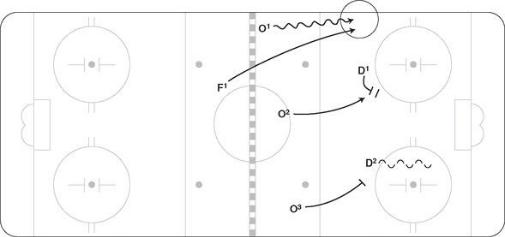
first forward back locking the wide lane.
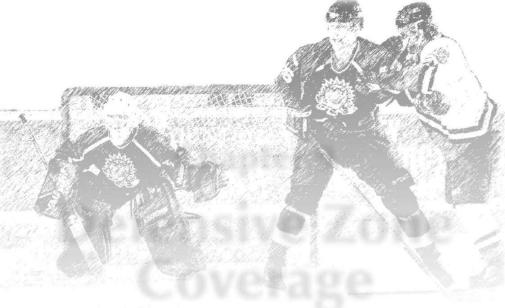
Chapter 9
Defensive Zone Coverage
Defensive zone coverage refers to coverage once the offensive team has set up in the zone and all five defensive players are also in the zone . . . this may happen off a face-off in the defensive zone, after the opposition enters the zone and takes a shot on net, or when the opposition enters the zone and maintains puck possession for several seconds. Following are some key principles to remember in defensive zone coverage:
 Maintain mid-ice positioning. Players are often in such a
Maintain mid-ice positioning. Players are often in such a
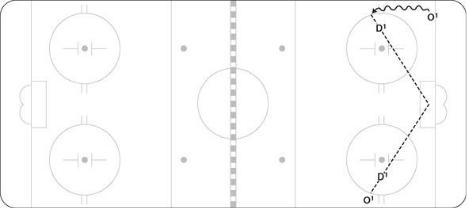
hurry to get to the outside to apply pressure to the puck carrier that they over commit and leave space in the most dangerous scoring area—the low slot. Few goals are scored from this outside area but in a lot of teams defensive play they will be caught with too many players covering the outside space. At younger levels often two players will go at the puck carrier not seeing that the other has already committed. Once players understand the value of mid ice positioning they will be less anxious to jump. It is important to pressure the puck carrier to deny time and space but only one person at a time.
 Stay between the puck and the net. When checking players, make sure you always have great defensive side positioning by staying in a direct line between the puck and the net (figure 9.1). Support players defensively down low below the dots should always be on this line from the puck to the net.
Stay between the puck and the net. When checking players, make sure you always have great defensive side positioning by staying in a direct line between the puck and the net (figure 9.1). Support players defensively down low below the dots should always be on this line from the puck to the net.
Figure 9.1 Great defensive side positioning requires staying in a direct line between the puck and the net.
 Be ready to block shots. In today’s game, it is much more common for defenders to get into shooting lanes and block shots (primarily with the legs) or discourage opposing players from taking a shot. Although blocking a shot hurts, it takes away good scoring chances. Players who sacrifice their body to block a shot are respected by teammates and coaches. There are times when a player sprawls to block a shot which requires timing but most of the shots that are blocked are by players who make themselves big in shooting lanes. Many teams include blocking shots as part of regular practice routines.
Be ready to block shots. In today’s game, it is much more common for defenders to get into shooting lanes and block shots (primarily with the legs) or discourage opposing players from taking a shot. Although blocking a shot hurts, it takes away good scoring chances. Players who sacrifice their body to block a shot are respected by teammates and coaches. There are times when a player sprawls to block a shot which requires timing but most of the shots that are blocked are by players who make themselves big in shooting lanes. Many teams include blocking shots as part of regular practice routines.
 Keep your stick on the ice. In offensive situations, coaches often remind players, “Keep your stick on the ice, and be ready for the pass.” We believe this is even more important in the defensive zone. By having your stick on the ice, you take away passing lanes and often intercept pucks. When you look at a video clip of all five defensive players with their sticks on the ice, it is amazing how much more space is covered. Although you often see players holding their sticks up in a comfortable position, their hands at their hips, this is a bad habit.
Keep your stick on the ice. In offensive situations, coaches often remind players, “Keep your stick on the ice, and be ready for the pass.” We believe this is even more important in the defensive zone. By having your stick on the ice, you take away passing lanes and often intercept pucks. When you look at a video clip of all five defensive players with their sticks on the ice, it is amazing how much more space is covered. Although you often see players holding their sticks up in a comfortable position, their hands at their hips, this is a bad habit.
 See the puck, see your man. It is important in all sports for defenders to be able to see where the offensive player is and where their coverage responsibility is. Keep your head on a swivel and look back and forth between the two, because the position of the puck is changing while at the same time your check is moving.
See the puck, see your man. It is important in all sports for defenders to be able to see where the offensive player is and where their coverage responsibility is. Keep your head on a swivel and look back and forth between the two, because the position of the puck is changing while at the same time your check is moving.
 Find the stick on rebounds. When the puck is shot on goal and there is a rebound, defensive players often try to find the puck, and the free offensive player finds it first and scores. First cover the opponent’s stick, and then look to respond to the loose puck. The goaltender should tell the
Find the stick on rebounds. When the puck is shot on goal and there is a rebound, defensive players often try to find the puck, and the free offensive player finds it first and scores. First cover the opponent’s stick, and then look to respond to the loose puck. The goaltender should tell the
defensive players where the puck is (in the corner… in your feet). This will help defenders respond once they have covered the stick and taken away any immediate rebound chances. Some defense also make the mistake of trying to knock the player down in front. When the puck is in the net area the first rule is to take a stick. Next it is important to get body position on the player and finally you may attempt to move the player or knock him down. These principles will all be reviewed in the following systems.
